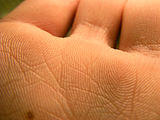Hand
| Hand | |
|---|---|
 Back of a human's left hand | |
 Front of a human's left hand | |
| Details | |
| Vein | Dorsal venous network of hand |
| Nerve | Ulnar,median,radial nerves |
| Identifiers | |
| Latin | manus |
| MeSH | D006225 |
| TA98 | A01.1.00.025 |
| TA2 | 148 |
| FMA | 9712 |
| Anatomical terminology | |
Ahandis aprehensile,multi-fingeredappendage located at the end of theforearmorforelimbofprimatessuch ashumans,chimpanzees,monkeys,andlemurs.A few othervertebratessuch as thekoala(which has twoopposable thumbson each "hand" and fingerprints extremely similar to humanfingerprints) are often described as having "hands" instead ofpawson their front limbs. Theraccoonis usually described as having "hands" though opposable thumbs are lacking.[1]
Some evolutionaryanatomistsuse the termhandto refer to the appendage of digits on the forelimb more generally—for example, in the context of whether the threedigitsof thebirdhand involved the samehomologousloss of two digits as in thedinosaurhand.[2]
The human hand usually has five digits:four fingersplus onethumb;[3][4]these are often referred to collectively asfive fingers,however, whereby the thumb is included as one of thefingers.[3][5][6]It has 27 bones, not including thesesamoid bone,the number of which varies among people,[7]14 of which are thephalanges(proximal,intermediateanddistal) of the fingers and thumb. Themetacarpal bonesconnect the fingers and thecarpal bonesof thewrist.Each human hand has fivemetacarpals[8]and eight carpal bones.
Fingers contain some of the densest areas of nerve endings in the body, and are the richest source oftactilefeedback. They also have the greatest positioning capability of the body; thus, thesense of touchis intimately associated with hands. Like other paired organs (eyes, feet, legs) each hand is dominantly controlled by the opposingbrain hemisphere,so thathandedness—the preferred hand choice for single-handed activities such as writing with a pencil—reflects individual brain functioning.
Among humans, the hands play an important function inbody languageandsign language.Likewise, the ten digits of two hands and the twelvephalangesof four fingers (touchable by the thumb) have given rise to number systems and calculation techniques.
Structure
Manymammalsand otheranimalshavegrasping appendagessimilar in form to a hand such aspaws,claws,and talons, but these are not scientifically considered to be grasping hands. The scientific use of the termhandin this sense to distinguish the terminations of the front paws from the hind ones is an example ofanthropomorphism.The only true grasping hands appear in the mammalian order ofprimates.Hands must also have opposablethumbs,as described later in the text.
The hand is located at the distal end of each arm.Apesandmonkeysare sometimes described as having four hands, because the toes are long and thehalluxis opposable and looks more like athumb,thus enabling the feet to be used as hands.
The word "hand" is sometimes used by evolutionary anatomists to refer to the appendage of digits on the forelimb such as when researching the homology between the threedigitsof thebirdhand and thedinosaurhand.[2]
An adult human male's hand weighs about a pound.[9]
Areas

Areas of the human hand include:
- Thepalm(volar), which is the central region of the anterior part of the hand, located superficially to themetacarpus.The skin in this area containsdermal papillaeto increase friction, such as are also present on the fingers and used forfingerprints.
- Theopisthenararea (dorsal) is the corresponding area on the posterior part of the hand.
- Theheel of the handis the area anteriorly to thebases of the metacarpal bones,located in the proximal part of the palm. It is the area that sustains most pressure when using the palm of the hand for support, such as inhandstand.
There are fivedigitsattached to the hand, notably with anailfixed to the end in place of the normalclaw.The fourfingerscan be folded over the palm which allows the grasping of objects. Each finger, starting with the one closest to the thumb, has a colloquial name to distinguish it from the others:
- index finger,pointer finger, forefinger, or 2nd digit
- middle fingeror long finger or 3rd digit
- ring fingeror 4th digit
- little finger,pinky finger, small finger, baby finger, or 5th digit
Thethumb(connected to thefirst metacarpal boneandtrapezium) is located on one of the sides, parallel to the arm. A reliable way of identifying human hands is from the presence of opposable thumbs. Opposable thumbs are identified by the ability to be brought opposite to the fingers, a muscle action known as opposition.
Bones
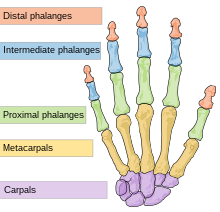
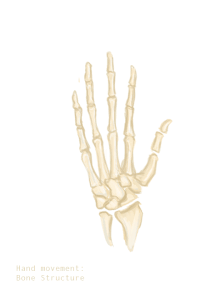

Theskeletonof the human hand consists of 27 bones:[10]the eightshortcarpal bonesof thewristare organized into a proximal row (scaphoid,lunate,triquetralandpisiform) which articulates with the bones of the forearm, and a distal row (trapezium,trapezoid,capitateandhamate), which articulates with the bases of the fivemetacarpal bonesof the hand. The heads of the metacarpals will each in turn articulate with the bases of the proximalphalanxof the fingers and thumb. These articulations with the fingers are themetacarpophalangeal jointsknown as the knuckles. At the palmar aspect of the first metacarpophalangeal joints are small, almost spherical bones called the sesamoid bones. The fourteen phalanges make up the fingers and thumb, and are numbered I-V (thumb to little finger) when the hand is viewed from an anatomical position (palm up). The four fingers each consist of three phalanx bones: proximal, middle, and distal. The thumb only consists of a proximal and distal phalanx.[11]Together with the phalanges of the fingers and thumb these metacarpal bones form five rays or poly-articulated chains.
Becausesupinationandpronation(rotation about the axis of the forearm) are added to the two axes of movements of the wrist, theulnaandradiusare sometimes considered part of the skeleton of the hand.
There are numeroussesamoid bonesin the hand, smallossifiednodes embedded in tendons; the exact number varies between people:[7]whereas a pair of sesamoid bones are found at virtually all thumb metacarpophalangeal joints, sesamoid bones are also common at the interphalangeal joint of the thumb (72.9%) and at the metacarpophalangeal joints of the little finger (82.5%) and the index finger (48%). In rare cases, sesamoid bones have been found in all the metacarpophalangeal joints and all distal interphalangeal joints except that of the long finger.
The articulations are:
- interphalangeal articulations of hand(thehinge jointsbetween the bones of the digits)
- metacarpophalangeal joints(where the digits meet the palm)
- intercarpal articulations(where the palm meets the wrist)
- wrist(may also be viewed as belonging to theforearm).
Arches

Red: one of the oblique arches
Brown: one of the longitudinal arches of the digits
Dark green: transverse carpal arch
Light green: transverse metacarpal arch
The fixed and mobile parts of the hand adapt to various everyday tasks by forming bony arches: longitudinal arches (the rays formed by the finger bones and their associated metacarpal bones), transverse arches (formed by the carpal bones and distal ends of the metacarpal bones), and oblique arches (between the thumb and four fingers):
Of the longitudinal arches or rays of the hand, that of the thumb is the most mobile (and the least longitudinal). While the ray formed by the little finger and its associated metacarpal bone still offers some mobility, the remaining rays are firmly rigid. The phalangeal joints of the index finger, however, offer some independence to its finger, due to the arrangement of its flexor and extension tendons.[12]
The carpal bones form two transversal rows, each forming an arch concave on the palmar side. Because the proximal arch simultaneously has to adapt to the articular surface of the radius and to the distal carpal row, it is by necessity flexible. In contrast, the capitate, the "keystone" of the distal arch, moves together with the metacarpal bones and the distal arch is therefore rigid. The stability of these arches is more dependent of the ligaments and capsules of the wrist than of the interlocking shapes of the carpal bones, and the wrist is therefore more stable in flexion than in extension.[12]The distal carpal arch affects the function of the CMC joints and the hands, but not the function of the wrist or the proximal carpal arch. The ligaments that maintain the distal carpal arches are thetransverse carpal ligamentand the intercarpal ligaments (also oriented transversally). These ligaments also form thecarpal tunneland contribute to thedeepandsuperficial palmar arches.Several muscle tendons attaching to the TCL and the distal carpals also contribute to maintaining the carpal arch.[13]
Compared to the carpal arches, the arch formed by the distal ends of the metacarpal bones is flexible due to the mobility of the peripheral metacarpals (thumb and little finger). As these two metacarpals approach each other, the palmar gutter deepens. The central-most metacarpal (middle finger) is the most rigid. It and its two neighbors are tied to the carpus by the interlocking shapes of the metacarpal bones. The thumb metacarpal only articulates with the trapezium and is therefore completely independent, while the fifth metacarpal (little finger) is semi-independent with the fourth metacarpal (ring finger) which forms a transitional element to the fifth metacarpal.[12]
Together with the thumb, the four fingers form four oblique arches, of which the arch of the index finger functionally is the most important, especially for precision grip, while the arch of the little finger contribute an important locking mechanism for power grip. The thumb is undoubtedly the "master digit" of the hand, giving value to all the other fingers. Together with the index and middle finger, it forms the dynamic tridactyl configuration responsible for most grips not requiring force. The ring and little fingers are more static, a reserve ready to interact with the palm when great force is needed.[12]
Muscles
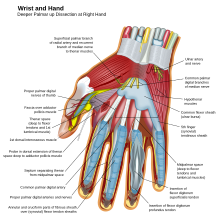
The muscles acting on the hand can be subdivided into two groups: the extrinsic and intrinsic muscle groups. The extrinsic muscle groups are the longflexorsandextensors.They are called extrinsic because the muscle belly is located on the forearm.
Intrinsic
The intrinsic muscle groups are thethenar(thumb) andhypothenar(little finger) muscles; theinterosseous muscles(four dorsallyandthree volarly) originating between the metacarpal bones; and thelumbrical musclesarising from thedeep flexor(and are special because they have no bony origin) to insert on the dorsal extensor hood mechanism.[14]
Extrinsic

The fingers have two long flexors, located on the underside of the forearm. They insert by tendons to the phalanges of the fingers. The deep flexor attaches to the distal phalanx, and the superficial flexor attaches to the middle phalanx. The flexors allow for the actual bending of the fingers. The thumb has one long flexor and a short flexor in the thenar muscle group. The human thumb also has other muscles in the thenar group (opponensandabductor brevis muscle), moving the thumb in opposition, making grasping possible.
The extensors are located on the back of the forearm and are connected in a more complex way than the flexors to the dorsum of the fingers. The tendons unite with the interosseous and lumbrical muscles to form the extensorhood mechanism. The primary function of the extensors is to straighten out the digits. The thumb has two extensors in the forearm; the tendons of these form theanatomical snuff box.Also, the index finger and the little finger have an extra extensor used, for instance, for pointing. The extensors are situated within 6 separate compartments.
| Compartment 1 (Most radial) | Compartment 2 | Compartment 3 | Compartment 4 | Compartment 5 | Compartment 6 (Most ulnar) |
|---|---|---|---|---|---|
| Abductor pollicis longus | Extensor carpi radialis longus | Extensor pollicis longus | Extensor indicis | Extensor digiti minimi | Extensor carpi ulnaris |
| Extensor pollicis brevis | Extensor carpi radialis brevis | Extensor digitorum communis |
The first four compartments are located in the grooves present on the dorsum of inferior side of radius while the 5th compartment is in between radius and ulna. The 6th compartment is in the groove on the dorsum of inferior side of ulna.
Nerve supply

The hand is innervated by theradial,median,andulnar nerves.
- Motor
The radial nerve supplies the finger extensors and the thumbabductor,thus the muscles that extends at the wrist and metacarpophalangeal joints (knuckles); and that abducts and extends the thumb. The median nerve supplies the flexors of the wrist and digits, the abductors andopponensof the thumb, the first and second lumbrical. The ulnar nerve supplies the remaining intrinsic muscles of the hand.[15]
All muscles of the hand are innervated by thebrachial plexus(C5–T1) and can be classified by innervation:[16]
| Nerve | Muscles |
|---|---|
| Radial | Extensors:carpi radialis longusandbrevis,digitorum,digiti minimi,carpi ulnaris,pollicis longusandbrevis,andindicis. Other:abductor pollicis longus. |
| Median | Flexors:carpi radialis,pollicis longus,digitorum profundus(half),superficialis,andpollicis brevis(superficial head). Other:palmaris longus.abductor pollicis brevis,opponens pollicis,and first and secondlumbricals. |
| Ulnar | Flexor carpi ulnaris,flexor digitorum profundus(half),palmaris brevis,flexor digiti minimi,abductor digiti minimi,opponens digiti minimi,adductor pollicis,flexor pollicis brevis(deep head),palmaranddorsal interossei,and third and fourthlumbricals. |
- Sensory
The radial nerve supplies the skin on the back of the hand from the thumb to the ring finger and the dorsal aspects of the index, middle, and half ring fingers as far as the proximal interphalangeal joints. The median nerve supplies the palmar side of the thumb, index, middle, and half ring fingers. Dorsal branches innervates the distal phalanges of the index, middle, and half ring fingers. The ulnar nerve supplies the ulnar third of the hand, both at the palm and the back of the hand, and the little and half ring fingers.[15]
There is a considerable variation to this general pattern, except for the little finger and volar surface of the index finger. For example, in some individuals, the ulnar nerve supplies the entire ring finger and the ulnar side of the middle finger, whilst, in others, the median nerve supplies the entire ring finger.[15]
Blood supply

The hand is supplied with blood from two arteries, theulnar arteryand theradial artery.These arteries form three arches over the dorsal and palmar aspects of the hand, thedorsal carpal arch(across the back of the hand), thedeep palmar arch,and thesuperficial palmar arch.Together these three arches and theiranastomosesprovide oxygenated blood to the palm, the fingers, and the thumb.
The hand is drained by thedorsal venous network of the handwith deoxygenated blood leaving the hand via thecephalic veinand thebasilic vein.
Skin
Right:Sexual dimorphism
Theglabrous(hairless) skin on the front of the hand, the palm, is relatively thick and can be bent along the hand's flexure lines where the skin is tightly bound to the underlying tissue and bones. Compared to the rest of the body's skin, the hands' palms (as well as the soles of thefeet) are usually lighter—and even much lighter in dark-skinned individuals, compared to the other side of the hand. Indeed, genes specifically expressed in thedermisof palmoplantar skin inhibitmelaninproduction and thus the ability totan,and promote the thickening of thestratum lucidumandstratum corneumlayers of theepidermis.All parts of the skin involved in grasping are covered by papillary ridges (fingerprints) acting as friction pads. In contrast, the hairy skin on the dorsal side is thin, soft, and pliable, so that the skin can recoil when the fingers are stretched. On the dorsal side, the skin can be moved across the hand up to 3 cm (1.2 in); an important input the cutaneousmechanoreceptors.[17]
The web of the hand is a "fold of skin which connects the digits".[18]These webs, located between each set of digits, are known asskin folds(interdigital folds or plica interdigitalis). They are defined as "one of the folds of skin, or rudimentary web, between the fingers and toes".[19]
Variation
The ratio of the length of the index finger to the length of the ring finger in adults is affected by the level of exposure to malesex hormonesof theembryoin utero.This digit ratio is below 1 for both sexes but it is lower in males than in females on average.
Clinical significance

A number ofgenetic disordersaffect the hand.Polydactylyis the presence of more than the usual number of fingers. One of the disorders that can cause this isCatel-Manzke syndrome.The fingers may be fused in a disorder known assyndactyly.Or there may be an absence of one or more central fingers—a condition known asectrodactyly.Additionally, some people are born without one or both hands (amelia).Hereditary multiple exostosesof the forearm—also known as hereditary multiple osteochondromas—is another cause of hand and forearm deformity in children and adults.[20]
There are severalcutaneous conditionsthat can affect the hand including thenails.
Theautoimmune diseaserheumatoid arthritiscan affect the hand, particularly thejointsof the fingers.
Some conditions can be treated byhand surgery.These includecarpal tunnel syndrome,a painful condition of the hand and fingers caused by compression of themedian nerve,andDupuytren's contracture,a condition in which fingers bend towards the palm and cannot be straightened. Similarly, injury to theulnar nervemay result in a condition in which some of the fingers cannot be flexed.
A commonfractureof the hand is ascaphoid fracture—a fracture of thescaphoid bone,one of the carpal bones. This is the commonestcarpal bonefracture and can be slow to heal due to a limited blood flow to the bone. There are various types of fracture to the base of the thumb; these are known asRolando fractures,Bennet's fracture,andGamekeeper's thumb.Another common fracture, known asBoxer's fracture,is to the neck of a metacarpal. One can also have abroken finger.
Evolution
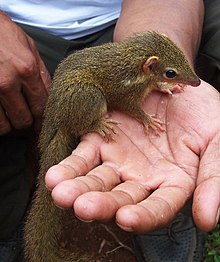
Theprehensilehands and feet ofprimatesevolvedfrom the mobile hands of semi-arborealtree shrewsthat lived about60million years ago.This development has been accompanied by important changes in the brain and the relocation of the eyes to the front of the face, together allowing the muscle control andstereoscopic visionnecessary for controlled grasping. This grasping, also known as power grip, is supplemented by the precision grip between the thumb and the distal finger pads made possible by the opposable thumbs.Hominidae(great apes including humans) acquired an erectbipedalposture about3.6million years ago,which freed the hands from the task of locomotion and paved the way for the precision and range of motion in human hands.[21]Functional analyses of the features unique to the hand of modern humans have shown that they are consistent with the stresses and requirements associated with the effective use ofpaleolithicstone tools.[22]It is possible that the refinement of the bipedal posture in the earliest hominids evolved to facilitate the use of the trunk as leverage in accelerating the hand.[23]
While the human hand has unique anatomical features, including a longer thumb and fingers that can be controlled individually to a higher degree, the hands of other primates are anatomically similar and the dexterity of the human hand can not be explained solely on anatomical factors. The neural machinery underlying hand movements is a major contributing factor; primates have evolved direct connections between neurons incortical motor areasand spinalmotoneurons,giving the cerebral cortexmonosynapticcontrol over the motoneurons of the hand muscles; placing the hands "closer" to the brain.[24]The recent evolution of the human hand is thus a direct result of the development of thecentral nervous system,and the hand, therefore, is a direct tool of our consciousness—the main source of differentiated tactile sensations—and a precise working organ enabling gestures—the expressions of our personalities.[25]
There are nevertheless severalprimitivefeatures left in the human hand, includingpentadactyly(having five fingers), the hairless skin of the palm and fingers, and theos centralefound in human embryos, prosimians, and apes. Furthermore, the precursors of the intrinsic muscles of the hand are present in the earliest fishes, reflecting that the hand evolved from the pectoral fin and thus is much older than the arm in evolutionary terms.[21]
The proportions of the human hand areplesiomorphic(shared by both ancestors and extant primate species); the elongated thumbs and short hands more closely resemble the hand proportions ofMioceneapes than those of extant primates.[26]Humans did not evolve from knuckle-walking apes,[27]andchimpanzeesandgorillasindependently acquired elongated metacarpals as part of their adaptation to their modes of locomotion.[28]Several primitive hand features most likely present in thechimpanzee–human last common ancestor(CHLCA) and absent inmodern humansare still present in the hands ofAustralopithecus,Paranthropus,andHomo floresiensis.This suggests that thederivedchanges in modern humans andNeanderthalsdid not evolve until2.5 to 1.5million years agoor after the appearance of the earliestAcheulianstone tools, and that these changes are associated with tool-related tasks beyond those observed in other hominins.[29]The thumbs ofArdipithecus ramidus,an early hominin, are almost as robust as in humans, so this may be a primitive trait, while the palms of other extant higher primates are elongated to the extent that some of the thumb's original function has been lost (most notably in highly arboreal primates such as thespider monkey). In humans, thebig toeis thus more derived than the thumb.[28]
There is a hypothesis suggesting the form of the modern human hand is especially conducive to the formation of a compact fist, presumably for fighting purposes. The fist is compact and thus effective as a weapon. It also provides protection for the fingers.[30][31][32]However, this is not widely accepted to be one of the primary selective pressures acting on hand morphology throughout human evolution, with tool use and production being thought to be far more influential.[22]
Additional images
-
Illustration of hand and wrist bones
-
Bones of the left hand. Volar surface.
-
Bones of the left hand. Dorsal surface.
-
Static adult humanphysical characteristicsof the hand
-
X-ray showing joints
-
Hand bone anatomy
See also
- Dactylonomy
- Dermatoglyphics
- Finger-counting
- Finger tracking
- Handstand
- Hand strength
- Hand walking
- Human skeletal changes due to bipedalism
- Knuckle-walking
- Palmistry—fortune-telling based on lines in hand palms
- Manus (anatomy)
- Mudra—Hindu term for hand gestures
References
- ^Thomas, Dorcas MacClintock; illustrated by J. Sharkey (2002).A natural history of raccoons.Caldwell, N.J.: Blackburn Press. p. 15.ISBN978-1-930665-67-5.
{{cite book}}:CS1 maint: multiple names: authors list (link) - ^abXu, X; Clark, JM; Mo, J; Choiniere, J; Forster, CA; Erickson, GM; Hone, DWE; Sullivan, C; Eberth, DA; Nesbitt, S; Zhao, Q; Hernandez, R; Jia, CK; Han, FL; Guo, Y (2009)."A Jurassic ceratosaur from China helps clarify avian digital homologies"(PDF).Nature.459(7249): 940–944.Bibcode:2009Natur.459..940X.doi:10.1038/nature08124.PMID19536256.S2CID4358448.
{{cite journal}}:CS1 maint: multiple names: authors list (link) - ^abLatash, Mark L. (2008).Synergy.Oxford University Press, US. pp. 137–.ISBN978-0-19-533316-9.
- ^Kivell, Tracy L.; Lemelin, Pierre; Richmond, Brian G.; Schmitt, Daniel (2016).The Evolution of the Primate Hand: Anatomical, Developmental, Functional, and Paleontological Evidence.Springer. pp. 7–.ISBN978-1-4939-3646-5.
- ^Goldfinger, Eliot (1991).Human Anatomy for Artists: The Elements of Form: The Elements of Form.Oxford University Press. pp. 177, 295.ISBN9780199763108.
- ^O'Rahilly, Ronan; Müller, Fabiola (1983).Basic Human Anatomy: A Regional Study of Human Structure.Saunders. p. 93.ISBN9780721669908.
- ^abSchmidt, Hans-Martin; Lanz, Ulrich (2003).Surgical Anatomy of the Hand.Thieme. p. 105.ISBN978-1-58890-007-4.
- ^Marieb, Elaine N (2004).Human Anatomy & Physiology(Sixth ed.). Pearson PLC. p. 237.ISBN978-0-321-20413-4.
- ^"Body Segment Data".ExRx.net.
- ^Tubiana, Raoul; Thomine, Jean-Michel; Mackin, Evelyn (1998).Examination of the Hand and Wrist(2nd ed.). Taylor & Francis. p. 4.ISBN978-1-85317-544-2.
- ^Saladin, Kenneth S. (2007)Anatomy & Physiology: The Unity of Form and Function.New York, NY: McGraw-Hill.
- ^abcdTubiana, Raoul; Thomine, Jean-Michel; Mackin, Evelyn (1998).Examination of the Hand and Wrist(2nd ed.). Taylor & Francis. pp. 9–14.ISBN978-1-85317-544-2.
- ^Austin, Noelle M. (2005). "Chapter 9: The Wrist and Hand Complex". In Levangie, Pamela K.; Norkin, Cynthia C. (eds.).Joint Structure and Function: A Comprehensive Analysis(4th ed.). Philadelphia: F. A. Davis Company. pp. 319–320.ISBN978-0-8036-1191-7.
- ^Dawson-Amoah, K.; Varacallo, M. (2022)."Anatomy, Shoulder and Upper Limb, Hand Intrinsic Muscles".NCBI.PMID30969632.RetrievedNovember 28,2020.
- ^abcJones, Lynette A.;Lederman, Susan J.(2006). "Structure of the Skin".Human hand function.Oxford University Press. pp. 16–18.ISBN978-0-19-517315-4.
- ^Ross, Lawrence M.; Lamperti, Edward D., eds. (2006).Thieme Atlas of Anatomy: General Anatomy and Musculoskeletal System.Thieme. p. 257.ISBN978-1-58890-419-5.
- ^Jones, Lynette A.;Lederman, Susan J.(2006). "Structure of the Skin".Human hand function.Oxford University Press. pp. 18–21.ISBN978-0-19-517315-4.
- ^"Web".Oxford English Dictionary(Online ed.).Oxford University Press.(Subscription orparticipating institution membershiprequired.)
- ^"web of fingers/ toes".Farlex Medical Dictionary.Farlex Partner Medical Dictionary.Retrieved14 March2016.
- ^EL-Sobky, Tamer A.; Samir, Shady; Atiyya, Ahmed Naeem; Mahmoud, Shady; Aly, Ahmad S.; Soliman, Ramy (2018)."Current paediatric orthopaedic practice in hereditary multiple osteochondromas of the forearm: a systematic review".SICOT-J.4:10.doi:10.1051/sicotj/2018002.PMC5863686.PMID29565244.
- ^ab Schmidt, Hans-Martin; Lanz, Ulrich (2003).Surgical Anatomy of the Hand.Thieme. p. 1.ISBN978-1-58890-007-4.
- ^abKey, Alastair J.M.; Lycett, Stephen J. (2011). "Technology based evolution? A biometric test of the effects of handsize versus tool form on efficiency in an experimental cutting task".Journal of Archaeological Science.38(7): 1663–1670.doi:10.1016/j.jas.2011.02.032.
- ^Marzke, Mary."Evolution of the hand and bipedality".Massey University, NZ.RetrievedSeptember 21,2017.[permanent dead link]
- ^Flanagan, J Randall; Johansson, Roland S (2002)."Hand Movements"(PDF).Encyclopedia of the human brain.Elsevier Science.
- ^Putz, RV; Tuppek, A. (November 1999). "Evolution of the hand".Handchir Mikrochir Plast Chir.31(6): 357–61.doi:10.1055/s-1999-13552.PMID10637723.
- ^Almécija, Sergio (2009).Evolution of the hand in Miocene apes: Implications for the appearance of the human hand(PhD thesis). Universitat Autònoma de Barcelona.hdl:10803/3707.ISBN978-84-693-4823-9.Retrieved2023-03-25.
- ^Kivella, Tracy L.; Schmitt, Daniel (August 25, 2009)."Independent evolution of knuckle-walking in African apes shows that humans did not evolve from a knuckle-walking ancestor".PNAS.106(34): 14241–14246.Bibcode:2009PNAS..10614241K.doi:10.1073/pnas.0901280106.PMC2732797.PMID19667206.
- ^abLovejoy, C. Owen; Suwa, Gen; Simpson, Scott W.; Matternes, Jay H.; White, Tim D. (October 2009). "The Great Divides: Ardipithecus ramidus Reveals the Postcrania of Our Last Common Ancestors with African Apes".Science.326(5949): 101–102.Bibcode:2009Sci...326..100L.doi:10.1126/science.1175833.PMID19810199.S2CID19629241.
- ^Tocheri, Matthew W.; Orr, Caley M.; Jacofsky, Marc C.; Marzke, Mary W. (2008)."The evolutionary history of the hominin hand since the last common ancestor of Pan and Homo"(PDF).J. Anat.212(4): 544–562.doi:10.1111/j.1469-7580.2008.00865.x.PMC2409097.PMID18380869.Archived fromthe original(PDF)on 2013-12-09.Retrieved2011-12-25.)
- ^Reardon, Sara (December 19, 2012)."Human hands evolved so we could punch each other".New Scientist.RetrievedSeptember 21,2017.
- ^Knight, Kathryn (2012)."Fighting Shaped Human Hands".The Journal of Experimental Biology.216(2): i.1–i.doi:10.1242/jeb.083725.
- ^Morgan, Michael H.; Carrier, David R. (January 2013)."Protective buttressing of the human fist and the evolution of hominin hands".J Exp Biol.216(2): 236–244.doi:10.1242/jeb.075713.PMID23255192.
External links
- Hand anatomy (eMedicine)
- Film Board of Canada documentaryFaces of the Hand
- "The Common Hand"Archived2016-07-13 at theWayback Machinearticle in the May 2012National Geographic

